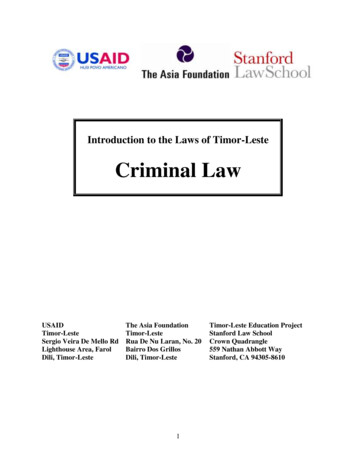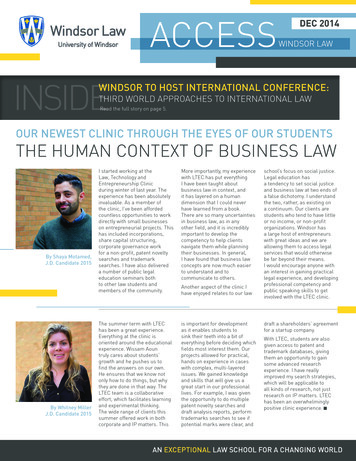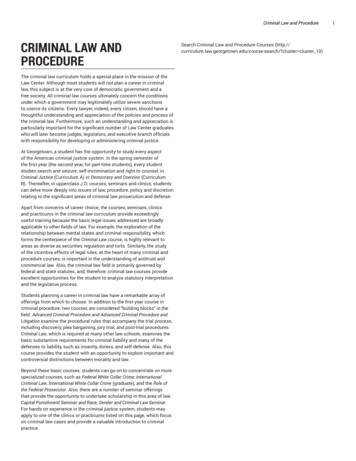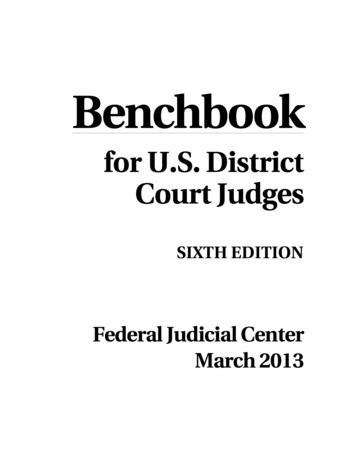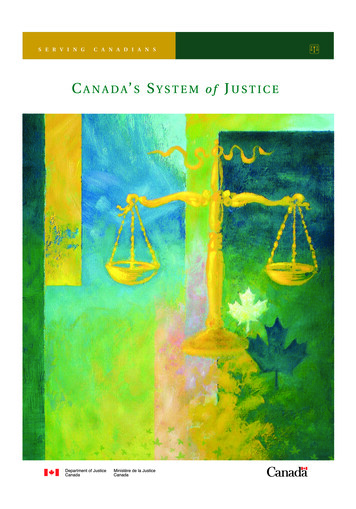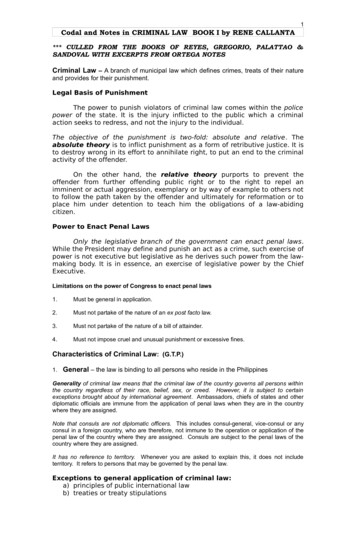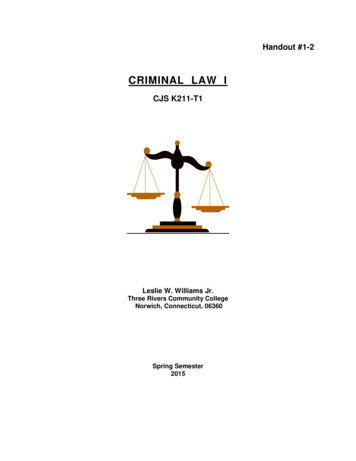
Transcription
Handout #1-2CRIMINAL LAW ICJS K211-T1Leslie W. Williams Jr.Three Rivers Community CollegeNorwich, Connecticut, 06360Spring Semester2015
I.COURSE TITLE: Criminal Law III.SPECIAL COURSE INFORMATION:A. Course Number: CJS K211 – T1 CRN #12007B. Room Number: D-104C. Semester Credit Hours: THREE (3)D. Pre-requisites: "Introduction to Law Enforcement and Criminal Justice"(CJS K101) and “Composition” (ENG K101) must be taken prior to this course.III.COURSE DESCRIPTION:This course involves comprehensive study of sources, distinctions and limitationsrelating to criminal law; the development of criminal law in the United States; theprinciples of criminal liability; the various crimes and their elements; and the criteriaconsidered in determining capacity and defenses. Connecticut Penal Code is used torelate Model Penal Code and Common Law materials specifically to Connecticut. Casestudies and briefs are used to emphasize the acts, the mental state and the attendantcircumstances that are necessary ingredients in proving crimes.IV.RATIONALE:State and federal statutes affecting conduct prior to birth and extending beyond deathguide individual behavior. Individuals are held accountable for their behavior duringevery waking moment. A vast legal network that outlines “appropriate” behaviorregulates our society. Laws, or codes of conduct have been developed to assure a moretranquil existence for all members of society. Although this course is required for criminaljustice students, anyone majoring in business or social science will benefit from thiscourse.V.GENERAL COURSE GOALS:A. Knowledge:1. To develop an understanding of criminal law as set forth in the State's Penalcode.2. To develop an understanding of the importance of "elements" of an offenseand the manner in which proof of these elements is established in court.3. To develop an understanding of the historical background of criminal law andthe basic elements of common law crimes.
V. (Continued)B. Attitude and Skills:1. To develop an awareness of the complexities involved in the criminal lawprocess.2. To identify elements of crimes and relate these to individual conduct ofpersons.3. To appreciate the scope and purposes of the criminal law.4. To appreciate the common defenses available to those charged with5. To read case reports, briefs and answer specific questions concerning theCases in writing. (Typewritten – single sided – #12 font – 1” margins –double line spacing – following the prescribed format provided).VI.INSTRUCTIONAL METHODS:Lectures, discussions, handouts, reading and writing assignments, class participation,case histories, written responses to discussion questions and visual aids, includingPowerPoint .VII.REQUIRED TEXT:"Criminal Law", John C. Klotter Justice Administration Legal Series, by Joycelyn M.Pollock, Tenth Edition, and Anderson Publishing is an imprint of Elsevier, Waltham, MA(2013).VIII.EVALUATION PROCEDURE:A. Written Quizzes - Three [3] objective tests will be given as follows:1. Covering Chapters 1, 2, 4 and 3. On or about March 3rd, the6th Session.2. Covering Chapters 5, 6, 7 and 8. On or about April 14th, the11th Session.3. Covering Chapters 10, 11, 12 and 15. On or about May 5th,The 14th Session.B. Case Reports - Five [5] typewritten reports on cases assigned will be due asassigned. Late case reports will be docked 10 points for EACH WEEKthey are late. 30 points if you were in class when assignment was due.C. Study Questions - Five [5] typewritten reports on questions taken fromdesignated text chapters as assigned in Session Outline. Late case reportswill be docked 10 points for EACH WEEK they are late. 30 points if youwere in class when assignment was due.NOTE: Assignments may be e-mailed, however a hard copy of thee-mailed assignment MUST be submitted at the next class session.VIII.(Con’t)
D. Grading Procedures - Letter grades will be assigned as follows:A 94 to100A- 90 to 93B 87 to 89B 83 to 86B- 80 to 82C 77 to 79C 73 to 76C- 70 to 72D 65 to 69D 60 to 64F Below 60I "Incomplete" - a temporary grade assigned to a student who does notcomplete the requirements of a course in the time allowed and whoreceived a written time extension from the instructor. The I must beresolved by the end of the 10th week of the next academic semester or itautomatically converts to an F.Withdrawal Policy A student who finds it necessary to discontinue acourse MUST complete a WITHDRAWAL form in the Registrar's Office atthe time of withdrawal. Students may withdraw from class anytime duringthe first ten (10) weeks without being in good standing or obtaining priorpermission of the instructor. After that period, a student wishing towithdraw must obtain written authorization of the instructor to receive a"W" grade for the course. Eligibility for refund of tuition is based upondate of withdrawal when received by the Registrar. Verbal withdrawalscannot be accepted.E. Final Grades - will be determined as follows:3 Quiz Grades - - - - - - - - - - - - - 5 Case Reports - - - - - - - - - - - - 5 Study Questions - - - - - - - - - - -48% [16% each]26% [ 5.2% each]26% [ 5.2% each]Total 100%IX.ATTENDANCE POLICY:Attendance is required at ALL class meetings. Absences will reflect in test grades asquiz questions are developed from the text and classroom presentations. Case reportsand Study Questions are due as assigned and absences will NOT excuse late paperswhich will be docked 10 points as previously described.X.DISABILITIES STATEMENT:Students with learning disabilities or ADD/ADHD should contact Chris Scarborough at860-215-9289. (Room A119D) Students with a physical, medical or psychiatric disabilitycontacts Kathleen Gray at 860-215-9248 (Room A119C) or Matt Liscum at 860-2159265 (Room A124).XISESSION OUTLINEAn outline is provided as a supplement to this syllabus that breaks down the materialthat is presented during each session. It also contains a list of handouts used during thesession and homework assignments. The outlined will be referenced at the beginning ofeach class session as an overview of the material to be presented.XIILEARNING PORTFOLIO
All students are required to maintain an online learning portfolio in Digication that usesthe college template.Student Centered Version:As a student you will maintain an online learning portfolio using a college-designedtemplate in Digication. Through this electronic tool you will have the opportunity tomonitor your own growth in college-wide learning. It may even help you determine amajor that is best suited to you. You will be able to keep and maintain your learningportfolio after graduation. A Three Rivers General Education Assessment Team willselect and review random works to improve the college experience for all. If your work isselected and reviewed for assessment purposes, it will remain anonymous and private.Digication provides a “place” where you will connect your learning from the classroom,college, and life in general. Sometimes when you review all of the work you have doneand think about it, you end up learning something different and perhaps unexpected.Please review your course outlines to determine what assignments to upload into theTRCC Digication template and please post your own choices, as well. Have fun inlearning!(Digication provides ePortfolio and Assessment Management Systems for K-12 andHigher Education Institutions.)https://www.digication.com(Welcome to Digication, a new concept in educational software that is easy to masterand simple to use. It has all the connectivity, file sharing and online publishing .)depaul.digication.com
XI. SESSION OUTLINEHandout #1-3The detailed session outline that follows should be used to guide your Notetaking,studying and reading assignments. It is YOUR responsibility to complete the assignmentslisted, and to ask for handouts that you may have missed.SESSION1st.1-27-15CONTENTInstructor-Student Introductions; Student Information SheetsCourse Syllabus - Course OutlineIntroduction to Criminal Law Crime in the United StatesHANDOUTS: “Student Information Sheet” #1-1“Course Syllabus” #1-2“Course Outline” #1-3U.S. Leads The World in Crime #1-4ASSIGNMENT: Read Chapter 1 – Text2nd.2-3-15Chapter 1 – Defining CrimeGoals of a democracyBranches of government and their role in the legal systemSources of LawDefinition of "Common Law"Limitations on criminal lawsHANDOUTS: "Capitall Lawes of the State of Connecticut - 1638" #2-1"Enactment and Requirements of Criminal Statutes" #2-2ASSIGNMENT: Read Chapter 2 - TextStudy Question #1 – As provided in Handout #2-33rd.2-10-15Chapter 1 (Continued)Crime DefinedClassification of crimes according to Nature, Degree and PunishmentDistinguish between crimes and tortsBurden of proof (criminal / civil)Chapter 2 – Principles of Criminal LiabilityParties to a crime Principals Accomplices AccessoriesCriminal attempt; ConspiracyHANDOUTS: "Classification of Crimes" #3-1“Case Report – Study Question – Format” #3-3ASSIGNMENT: Read Chapter 4 – TextCase Report #1 "Parties to a Crime" #3-2
4th2-17-15Principles of Criminal Liability (Con’t) Mens Rea Actus Reus Concurrence CausationChapter 4 – Preparatory Activity Crimes – Attempt and ConspiracyHANDOUTS: “Degrees of Mental Fault” #4-1“Proof of Cause or Causation” #4-2ASSIGNMENT: Read Chapter 3 - TextCase Report #2 “Criminal Liability” #4-35th2-24-15Chapter 3 – Capacity and Defenses Legal principles of Motive and Intent Infancy or Immaturity Mental Impairment Duress or Compulsion Self-Defense (Use of Force) Entrapment Ignorance or Mistake Statute of LimitationsHANDOUT: "Use of Force" #5-1ASSIGNMENT: Study for Quiz #1Read Chapter 5 - Text6th3-3-15* * * * * * * * * * * * * * * * * * 1st Quiz * * * * * * * * * * * * * * * * * * * * * * * * * * * *Chapter 5 - Offenses Against Persons (Excluding Sex Offenses) Homicide Defined Types of homicide – MurderHANDOUT: "Homicide Chart" #6-1“Connecticut Homicide Statutes” #6-2ASSIGNMENT: Case Reports #3 "The Doctrine of Transferred Intent” #6-3#4 "Heat of Passion" #6-47th.3-10-15Review 1st QuizContinue with Offenses Against Persons – Types of Homicide Capital Felony Murder Felony Murder; Arson Murder ManslaughterASSIGNMENT: Study Question #2 – Drop down box p.165 – Text(State v. Thornton p.693)Case Report #5 "Consent/Assault" #7-23-17-15 * * * * * * * * Semester Break * * * * * * * Be Safe * * * * * * * * *
8th.3-24-15Continue with Offenses Against Persons Voluntary Manslaughter Involuntary Manslaughter Motor Vehicle ManslaughterConnecticut Death Penalty StatuteHANDOUT: "Connecticut Death Penalty Procedure" #8-1"Assault Definitions" #8-2ASSIGNMENT: Study Question #3 – Questions p. 219 Drop down box(Lawrence et al. v. Texas p. 710 – Text)Read Chapters 6 - Text9th3-31-15Contimue with Offenses Against Persons Assault and Battery* Threatening Kidnapping and Related OffensesChapter 6 – Offenses Against Persons – Sex Related Sexual Assault and other related offenses Rape Shield StatutesHANDOUTS: "Sexual Assault Definitions" #9-1“Sexual Assault Offenses” #9-2ASSIGNMENT: Study Question #4 – Questions p. 291 Drop down box(Lattimore v. United States p. 725 – Text)Read Chapters 7 and 8 – Text10th4-7-15Chapter 7 - Offenses Against Property – Destruction and Intrusion Offenses Arson* Criminal Mischief Burglary Criminal TrespassChapter 8 – Offenses Involving Theft Robbery Larceny Embezzlement Extortion Receiving Stolen PropertyHANDOUTS: "Burgulary Definitions” #10-1“Larceny Statute" #10-2"Comparison of Burglary, Larceny and Robbery" #10-3ASSIGNMENT: Study for Quiz #2Read Chapters 9 and 10 – Text11th* * * * * * * * * * * * * * * * * * 2nd Quiz * * * * * * * * * * * * * * * * * * * * * * * * *
4-14-1512th4-21-15Chapter 9 – Forgery and Other Fraud Offenses Forgery Identity Theft Computer CrimesChapter 10 - Offenses Involving Morality and Decency Adultery and Fornication Prostitution and Related Offenses Obscenity AbortionASSIGNMENT: Read Chapter 11 – TextReview 2nd QuizChapter 11 - Offenses against the Public Peace Riot and Related Offenses Disorderly Conduct – Breach of Peace Vagrancy and Loitering Drug Laws Wiretapping and EavesdroppingHANDOUT: “Breach, Stalking, Intimidation, Disorderly Conduct” #12-1ASSIGNMENT: Read – Chapter 12 and 15Study Question #5 – Briefly summarize the provisions ofthe following (Environmental Laws), (1) Clean Air Act; (2)Safe Drinking Water Act; (3) Clean Water Act; (4) ToxicSubstance Control Act; (5) Resource Conservation andRecovery Act.13th4-28-15Chapter 12 - Offenses Against Public Justice and Administration Perjury Bribery Obstructing Justice Escape Resisting ArrestChapter 15 – Corporate and Computer Crimes Racketeer Influenced and Corrupt Organizations Act (RICO) Mail and Wire Fraud Environmental CrimesASSIGNMENT: Study for Quiz #315th5-5-1515th5-12-15******************3rd Quiz************************Review Quiz #3Review Final Grade TabulationsInstructor/Course Critique and EvaluationL Leslie W. Williams Jr.10 Duchess DriveOld Lyme, CT. 06371(H) 860-434-0753 (Eve)(W) 860-887-1214 (Mon. – Thurs.)e-mail: lescsp20@snet.net
1. To develop an understanding of criminal law as set forth in the State's Penal code. 2. To develop an understanding of the importance of "elements" of an offense and the manner in which proof of these elements is established in court. 3. To develop an understanding of the historical background of criminal law and

